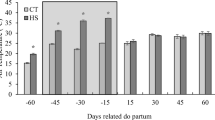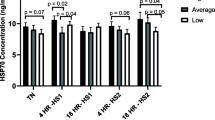Abstract
Pelibuey and Suffolk sheep were compared as to their capacity to regulate body temperature under environmental hyperthermia by measuring their differences in cellular response to heat stress (HS). In a first experiment, seven Pelibuey and seven Suffolk ewes were kept in a climatic chamber for 6 h daily during 10 days (temperatures within the 18 to 39.5 °C range). As chamber temperature rose, sheep rectal temperature increased in both groups, but to a lesser extent in Pelibuey (0.3 °C) than in Suffolk sheep (0.7 °C) (P < 0.05). In a second experiment, cellular viability was assessed using cultured blood mononuclear cells from 15 Pelibuey and 15 Suffolk sheep. They were incubated at 37 °C for 24 h (control) or 43 °C for 6 h followed by 18 h at 37 °C (HS). In a third experiment, another blood mononuclear cells culture from eight Pelibuey and eight Suffolk sheep was kept at 37 °C for 15 h; these were subsequently cultured for 6 h at 37 °C (controls) or 43 °C (HS). Next, HSP-70 concentration was determined. HS reduced the percentage of viable cells to a greater extent in Suffolk [37 °C (73.7 %) vs. 43 °C (61.9 %); P < 0.05] than in Pelibuey sheep [37 °C (74.9 %) vs. 43 °C (66.7 %); P > 0.05]. HS significantly increased HSP-70 average concentrations for both breeds at 43 °C. A significant effect was observed for the breed by temperature interaction (P < 0.05) caused by a greater difference between Pelibuey and Suffolk at 43 °C (2.85 vs. 0.53 ng/mL, respectively; P < 0.05) than at 37 °C (0.05 vs. 0.03 ng/mL, respectively; P > 0.05). In conclusion, Pelibuey sheep show more effective body temperature regulation under conditions of environmental hyperthermia. Also, cell viability after HS was higher in Pelibuey than in Suffolk, an effect that could be mediated by an HSP-70-related mechanism.


Similar content being viewed by others
References
Agnew, L.L., Colditz, I.G., 2008. Development of a method of measuring cellular stress in cattle and sheep, Veterinary Immunology and Immunopathology, 123, 197–204.
Alhidary, I.A., Shini, S., Al Jassim, R.A.M., Gaughan, J.B., 2012. Physiological responses of Australian Merino wethers exposed to high heat load, Journal of Animal Science, 90, 212–220.
Angelidis, C.E., Lazaridis, I., Pagoulatos, G.N., 1991. Constitutive expression of heat shock protein 70 in mammalian cells confers thermoresistance, European Journal of Biochemistry, 199, 35–39.
Basiricó, L., Morera, P., Primi, V., Lacetera, N., Nardone, A., Bernabucci, U., 2011. Cellular thermotolerance is associated with heat shock protein 70.1 genetic polymorphisms in Holstein lactating cows, Cell Stress and Chaperones, 16, 441–448.
Castanheira, M., Paiva, S.R., Louvandini, H., Landim, A., Soares Fiorvanti, M.C., Dallago, B.S., Correa, P.S., McManus, C., 2010. Use of heat tolerance traits in discriminating between groups of sheep in central Brazil, Tropical Animal Health and Production, 42, 1821–1828.
Chong, E., Dysart, K.C., Chidekel, A., Locke, R., Shaffer, T.H., Miller, T.L., 2009. Heat shock protein 70 secretion by neonatal tracheal tissue during mechanical ventilation: association with indices of tissue function and modeling, Pediatric Research, 65, 387–391.
Delgado, J.V., Perezgrovas, R., Camacho, M.E., Fresno, M., Barba, C., 2000. The Wool-Less Canary Sheep and their relationship with the present breeds in America, Animal Genetic Resources Information, 28, 27–34.
Finch, V.A., 1986. Body temperature in beef cattle: Its control and relevance to production in the tropics, Journal of Animal Science, 62, 531–542.
Finocchiaro, R., Van Kaam, J.B.C.H.M., Portolano, B., Misztal, I., 2005. Effect of heat stress on production of Mediterranean dairy sheep, Journal of Dairy Science, 88, 1855–1864.
García de, M.E., 1987. Modificaciones al sistema de clasificación climatológica de Koëppen, (Instituto de Geografía, Universidad Nacional Autónoma de México).
Gutiérrez, M.J., 2001. Efecto del cruzamiento con Suffolk y Rambouillet sobre el rendimiento, composición y calidad de la canal de Pelibuey, (tesis de maestría no publicada, Universidad Nacional Autónoma de México).
Hammond, A.C., Olson, T.A., Chase, Jr. C.C., Bowers, E.J., Randel, R.D., Murphy, C.N., Vogt, D.W., Tewolde, A., 1996. Heat tolerance in two tropically adapted Bos taurus breeds, Senepol and Romosinuano, compared with Brahman, Angus and Hereford cattle in Florida, Journal of Animal Science, 74, 295–303.
Hansen, P.J., 1999. Possible roles for heat shock protein 70 and glutathione in protection of the mammalian preimplantation embryo from heat shock, Annual Review of Biomedical Sciences, 1, 5–29.
Hansen, P.J., 2004. Physiological and cellular adaptations of zebu cattle to thermal stress. Animal Reproduction Science, 82–83, 349–360.
Hernández-Cerón, J., Chase, Jr. C.C., Hansen, P.J., 2004. Differences in Heat Tolerance Between Preimplantation Embryos from Brahman, Romosinuano, and Angus Breeds, Journal of Dairy Science, 87, 53–58.
Horowitz, M., 2002. From molecular and cellular to integrative heat defense during exposure to chronic heat, Comparative Physiology and Biochemistry, 131, 475–483.
Ju, J.C., 2005. Cellular responses of oocytes and embryos under thermal stress: hints to molecular signalling, Animal Reproduction, 2, 79–90.
Kamwanja, L.A., Chase, Jr C.C., Gutierrez, J.A., Guerriero, Jr V., Olson, T.A., Hammond, A.C., Hansen, P.J., 1994. Responses of bovine lymphocytes to heat shock as modified by breed and antioxidant status, Journal of Animal Science, 72, 438–444.
Lacetera, N., Bernabucci, U., Scalia, D., Basirico, L., Morera, P., Nardone, A., 2006. Heat stress elicits different responses in peripheral blood mononuclear cells from Brown Swiss and Holstein cows, Journal of Dairy Science, 89, 4606–4612.
Lindsay, D.R., Knight, T.W., Smith, J.F., Oldham, C.M., 1975. Studies in ovine fertility in agricultural regions of Western Australia: ovulation rate, fertility and lambing performance, Australian Journal of Agricultural Research, 26, 189–198.
Marai, I.F.M., El-Darawany, A.A., Fadiel, A., Abdel-Hafez, M.A.M., 2007. Physiological traits as affected by heat stress in sheep—A review, Small Ruminant Research, 71, 1–12.
Mason, I.L. 1988. World Dictionary of Livestock Breeds. C.A.B International, Wallington
Meza-Herrera, C.A., Martínez, L., Aréchiga, C., Bañuelos, R., Rincón, R.M., Urrútia, J., Salinas, H., Mellado, M., 2006. Circannual identification and quantification of constitutive heat shock proteins (HSP 70) in goats, Journal of Applied Animal Research, 29, 9–12.
Naqvi, S.M.K., Maurya, V.P., Gulyani, R., Joshi, A., Mittal, J.P., 2004. The effect of thermal stress on superovulatory response and embryo production in Bharat Merino ewes, Small Ruminant Research, 55, 57–63.
Paula-Lopes, F.F., Chase, Jr. C.C., Al-Katanani, Y.M., Krininger III, C.E., Rivera, R.M., Tekin, S., Majewski, A.C., Ocon, O.M., Olson, T.A., Hansen, P.J., 2003. Genetic divergence in cellular resistance to heat shock in cattle: differences between breeds developed in temperate versus hot climates in responses of preimplantation embryos, reproductive tract tissues and lymphocytes to increased culture temperatures, Reproduction, 125, 285–294.
Payne, R.W., Murray, D.A., Harding, S.A., Baird, D.B., Soutar, D.M., 2009. GenStat for Windows, (VSN International, Hemel Hempstead).
Ross, T.T., Goode, D., Linnerud, A.C., 1985. Effects of high ambient temperature on respiration rate, rectal temperature, fetal development and thyroid gland activity in tropical and temperate breeds of sheep, Theriogenology, 24, 259–269.
Su, F., Nguyen, N.D., Wang, Z., Cai, Y., Rogiers, P., Vincent, J.L., 2005. Fever control in septic shock: beneficial or harmful?, Shock, 23, 516–520.
Tabarez-Rojas, A., Porras-Almeraya, A., Vaquera-Huerta, H., Hernández-Ignacio, J., Valencia, J., Rojas-Maya, S., Hernández-Cerón, J., 2009. Desarrollo embrionario en ovejas Pelibuey y Suffolk en condiciones de estrés calórico, Agrociencia, 43, 671–680.
Acknowledgments
The authors are grateful for the financial support granted by the Programa de Apoyo a Proyectos de Investigación e Innovación Tecnológica from the Universidad Nacional Autónoma de México, project no. IN222305. Help from María Isabel Pérez Montfort in English editing is appreciated.
Conflict of Interest
The authors declare that they have no conflict of interest.
Ethical standard
This study was approved by the National University of Mexico Institutional Animal Care and Use Committee.
Author information
Authors and Affiliations
Corresponding author
Rights and permissions
About this article
Cite this article
Romero, R.D., Montero Pardo, A., Montaldo, H.H. et al. Differences in body temperature, cell viability, and HSP-70 concentrations between Pelibuey and Suffolk sheep under heat stress. Trop Anim Health Prod 45, 1691–1696 (2013). https://doi.org/10.1007/s11250-013-0416-1
Accepted:
Published:
Issue Date:
DOI: https://doi.org/10.1007/s11250-013-0416-1




